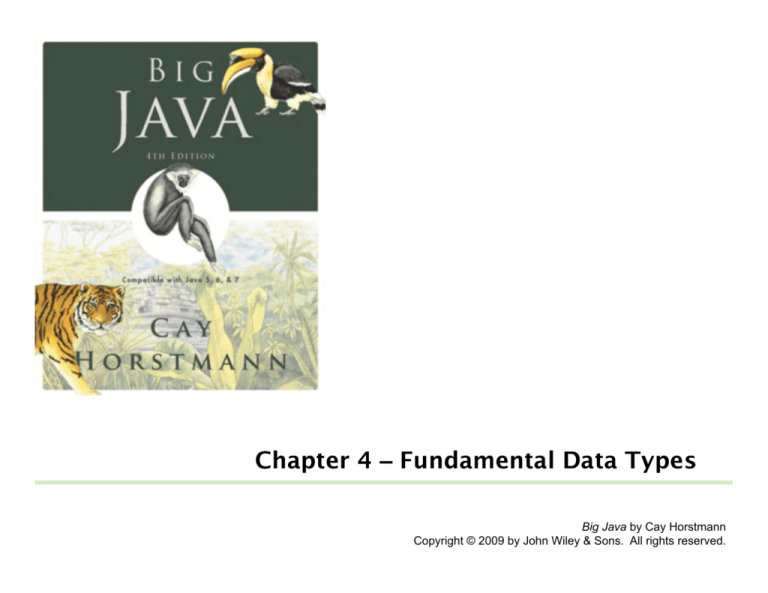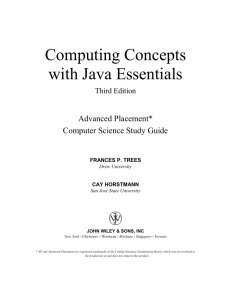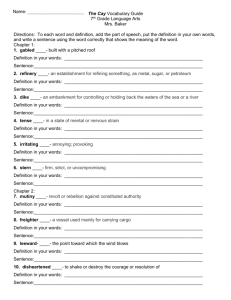
Chapter 4 – Fundamental Data Types
Big Java by Cay Horstmann
Copyright © 2009 by John Wiley & Sons. All rights reserved.
ICOM 4015: Advanced
Programming Lecture 4
Reading: Chapter Four: Fundamental Data Types
Big Java by Cay
Horstmann
Copyright © 2009 by John
Wiley & Sons. All rights
reserved.
Big Java by Cay Horstmann
Copyright © 2009 by John Wiley & Sons. All rights reserved.
Chapter Goals
• To understand integer and floating-point numbers
• To recognize the limitations of the numeric types
• To become aware of causes for overflow and roundoff errors
• To understand the proper use of constants
• To write arithmetic expressions in Java
• To use the String type to define and manipulate character
strings
• To learn how to read program input and produce formatted
output
Big Java by Cay Horstmann
Copyright © 2009 by John Wiley & Sons. All rights reserved.
Key Concepts
• Computer Numbers ≠ Math Numbers
• All computer data is encoded as bit strings
• Use named constants to avoid hardcoding
“magic numbers”
• Numbers ≠ Numerals
Big Java by Cay Horstmann
Copyright © 2009 by John Wiley & Sons. All rights reserved.
Number Types
• int: integers, no fractional part:
1, -4, 0
• double: floating-point numbers (double precision):
0.5, -3.11111, 4.3E24, 1E-14
• A numeric computation overflows if the result falls outside the
range for the number type:
int n = 1000000;
System.out.println(n * n); // prints -727379968
• Java: 8 primitive types, including four integer types and two
floating point types
Big Java by Cay Horstmann
Copyright © 2009 by John Wiley & Sons. All rights reserved.
Primitive Types
Type
Description
Size
int
The integer type, with range -2,147,483,648 . . . 2,147,483,647
4 bytes
byte
The type describing a single byte, with range -128 . . . 127
1 byte
short
The short integer type, with range -32768 . . . 32767
2 bytes
long
The long integer type, with range
-9,223,372,036,854,775,808 . . . 9,223,372,036,854,775,807
8 bytes
double
The double-precision floating-point type, with a range of about ±10308 and
about 15 significant decimal digits
8 bytes
float
The single-precision floating-point type, with a range of about ±1038 and
about 7 significant decimal digits
4 bytes
char
The character type, representing code units in the Unicode encoding
scheme
2 bytes
boolean
The type with the two truth values false and true
1 bit
Big Java by Cay Horstmann
Copyright © 2009 by John Wiley & Sons. All rights reserved.
Coding Methods for Numeric Types
2’s Complement Coding for Positive and Negative Integers
Big Java by Cay Horstmann
Copyright © 2009 by John Wiley & Sons. All rights reserved.
Coding Methods for Numeric Types
IEEE 754 Standard for Floating Point Numbers
Big Java by Cay Horstmann
Copyright © 2009 by John Wiley & Sons. All rights reserved.
Number Types: Floating-point Types
• Rounding errors occur when an exact conversion between
numbers is not possible:
double f = 4.35;
System.out.println(100 * f); // prints 434.99999999999994
• Java: Illegal to assign a floating-point expression to an integer
variable:
double balance = 13.75;
int dollars = balance; // Error
Big Java by Cay Horstmann
Copyright © 2009 by John Wiley & Sons. All rights reserved.
Self Check 4.1
Which are the most commonly used number types in Java?
Answer: int and double
Big Java by Cay Horstmann
Copyright © 2009 by John Wiley & Sons. All rights reserved.
Self Check 4.2
Suppose you want to write a program that works with population
data from various countries. Which Java data type should you
use?
Answer: The world’s most populous country, China, has
about 1.2 x 109 inhabitants. Therefore, individual population
counts could be held in an int. However, the world population is
over 6 × 109. If you compute totals or averages of multiple
countries, you can exceed the largest int value. Therefore,
double is a better choice. You could also use long, but there is
no benefit because the exact population of a country is not
known at any point in time.
Big Java by Cay Horstmann
Copyright © 2009 by John Wiley & Sons. All rights reserved.
Self Check 4.3
Which of the following initializations are incorrect, and why?
a. int dollars = 100.0;
b. double balance = 100;
Answer: The first initialization is incorrect. The right hand side
is a value of type double, and it is not legal to initialize an int
variable with a double value. The second initialization is
correct — an int value can always be converted to a double.
Big Java by Cay Horstmann
Copyright © 2009 by John Wiley & Sons. All rights reserved.
Constants: final
• A final variable is a constant
• Once its value has been set, it cannot be changed
• Named constants make programs easier to read and maintain
• Convention: Use all-uppercase names for constants
final double QUARTER_VALUE = 0.25;
final double DIME_VALUE = 0.1;
final double NICKEL_VALUE = 0.05;
final double PENNY_VALUE = 0.01;
payment = dollars + quarters * QUARTER_VALUE
+ dimes * DIME_VALUE + nickels * NICKEL_VALUE
+ pennies * PENNY_VALUE;
Big Java by Cay Horstmann
Copyright © 2009 by John Wiley & Sons. All rights reserved.
Constants: static final
• If constant values are needed in several methods, declare them
together with the instance fields of a class and tag them as
static and final
• Give static final constants public access to enable other
classes to use them
public class Math
{
. . .
public static final double E = 2.7182818284590452354;
public static final double PI = 3.14159265358979323846;
}
double circumference = Math.PI * diameter;
Big Java by Cay Horstmann
Copyright © 2009 by John Wiley & Sons. All rights reserved.
Syntax 4.1 Constant Definition
Big Java by Cay Horstmann
Copyright © 2009 by John Wiley & Sons. All rights reserved.
ch04/cashregister/CashRegister.java
/**
A cash register totals up sales and computes change due.
*/
public class CashRegister
{
public static final double
public static final double
public static final double
public static final double
QUARTER_VALUE = 0.25;
DIME_VALUE = 0.1;
NICKEL_VALUE = 0.05;
PENNY_VALUE = 0.01;
private double purchase;
private double payment;
/**
Constructs a cash register with no money in it.
*/
public CashRegister()
{
purchase = 0;
payment = 0;
}
Continued
Big Java by Cay Horstmann
Copyright © 2009 by John Wiley & Sons. All rights reserved.
ch04/cashregister/CashRegister.java (cont.)
/**
Records the purchase price of an item.
@param amount the price of the purchased item
*/
public void recordPurchase(double amount)
{
purchase = purchase + amount;
}
/**
Enters the payment received from the customer.
@param dollars the number of dollars in the payment
@param quarters the number of quarters in the payment
@param dimes the number of dimes in the payment
@param nickels the number of nickels in the payment
@param pennies the number of pennies in the payment
*/
public void enterPayment(int dollars, int quarters,
int dimes, int nickels, int pennies)
{
payment = dollars + quarters * QUARTER_VALUE + dimes * DIME_VALUE
+ nickels * NICKEL_VALUE + pennies * PENNY_VALUE;
}
Continued
Big Java by Cay Horstmann
Copyright © 2009 by John Wiley & Sons. All rights reserved.
ch04/cashregister/CashRegister.java (cont.)
/**
Computes the change due and resets the machine for the next customer.
@return the change due to the customer
*/
public double giveChange()
{
double change = payment - purchase;
purchase = 0;
payment = 0;
return change;
}
}
Big Java by Cay Horstmann
Copyright © 2009 by John Wiley & Sons. All rights reserved.
ch04/cashregister/CashRegisterTester.java
/**
This class tests the CashRegister class.
*/
public class CashRegisterTester
{
public static void main(String[] args)
{
CashRegister register = new CashRegister();
register.recordPurchase(0.75);
register.recordPurchase(1.50);
register.enterPayment(2, 0, 5, 0, 0);
System.out.print("Change: ");
System.out.println(register.giveChange());
System.out.println("Expected: 0.25");
register.recordPurchase(2.25);
register.recordPurchase(19.25);
register.enterPayment(23, 2, 0, 0, 0);
System.out.print("Change: ");
System.out.println(register.giveChange());
System.out.println("Expected: 2.0");
}
}
Big Java by Cay Horstmann
Copyright © 2009 by John Wiley & Sons. All rights reserved.
ch04/cashregister/CashRegisterTester.java (cont.)
Program Run:
Change: 0.25
Expected: 0.25
Change: 2.0
Expected: 2.0
Big Java by Cay Horstmann
Copyright © 2009 by John Wiley & Sons. All rights reserved.
Self Check 4.4
What is the difference between the following two statements?
final double CM_PER_INCH = 2.54;
and
public static final double CM_PER_INCH = 2.54;
Answer: The first definition is used inside a method, the second
inside a class.
Big Java by Cay Horstmann
Copyright © 2009 by John Wiley & Sons. All rights reserved.
Self Check 4.5
What is wrong with the following statement sequence?
double diameter = . . .;
double circumference = 3.14 * diameter;
Answer:
1. You should use a named constant, not the “magic
number” 3.14.
2. 3.14 is not an accurate representation of π.
Big Java by Cay Horstmann
Copyright © 2009 by John Wiley & Sons. All rights reserved.
Arithmetic Operators
• Four basic operators:
•
addition: +
•
subtraction: -
•
multiplication: *
•
division: /
• Parentheses control the order of subexpression computation:
(a + b) / 2
• Multiplication and division bind more strongly than addition and
subtraction:
(a + b) / 2
Big Java by Cay Horstmann
Copyright © 2009 by John Wiley & Sons. All rights reserved.
Increment and Decrement
• items++ is the same as items = items + 1
• items-- subtracts 1 from items
Big Java by Cay Horstmann
Copyright © 2009 by John Wiley & Sons. All rights reserved.
Integer Division
• / is the division operator
• If both arguments are integers, the result is an integer. The
remainder is discarded
• 7.0 / 4 yields 1.75
7 / 4 yields 1
• Get the remainder with % (pronounced “modulo”)
7 % 4 is 3
Big Java by Cay Horstmann
Copyright © 2009 by John Wiley & Sons. All rights reserved.
Integer Division
Example:
final
final
final
final
int
int
int
int
PENNIES_PER_NICKEL = 5;
PENNIES_PER_DIME = 10;
PENNIES_PER_QUARTER = 25;
PENNIES_PER_DOLLAR = 100;
// Compute total value in pennies
int total = dollars * PENNIES_PER_DOLLAR + quarters
* PENNIES_PER_QUARTER + nickels * PENNIES_PER_NICKEL
+ dimes * PENNIES_PER_DIME + pennies;
// Use integer division to convert to dollars, cents
int dollars = total / PENNIES_PER_DOLLAR;
int cents = total % PENNIES_PER_DOLLAR;
Big Java by Cay Horstmann
Copyright © 2009 by John Wiley & Sons. All rights reserved.
Compute Change With Minimal Coins
Big Java by Cay Horstmann
Copyright © 2009 by John Wiley & Sons. All rights reserved.
Powers and Roots
• Math class: contains methods sqrt and pow to compute
square roots and powers
• To compute xn, you write Math.pow(x, n)
• However, to compute x2 it is significantly more efficient simply
to compute x * x
• To take the square root of a number, use Math.sqrt; for
example, Math.sqrt(x)
• In Java,
can be represented as
(-b + Math.sqrt(b * b - 4 * a * c)) / (2 * a)
Big Java by Cay Horstmann
Copyright © 2009 by John Wiley & Sons. All rights reserved.
Use Parenthesis to Override Operator Precedence
Big Java by Cay Horstmann
Copyright © 2009 by John Wiley & Sons. All rights reserved.
Some (Static) Methods Available in the Math Built-in Class
Function
Returns
Math.sqrt(x)
square root
Math.pow(x, y)
power xy
Math.exp(x)
ex
Math.log(x)
natural log
Math.sin(x), Math.cos(x),
Math.tan(x)
sine, cosine, tangent
(x in radians)
Math.round(x)
closest integer to x
Math.min(x, y), Math.max(x, y)
minimum, maximum
Big Java by Cay Horstmann
Copyright © 2009 by John Wiley & Sons. All rights reserved.
Cast and Round
• Cast converts a value to a different type:
double balance = total + tax;
int dollars = (int) balance;
• Math.round converts a floating-point number to nearest
integer:
long rounded = Math.round(balance);
// if balance is 13.75, then rounded is set to 14
Big Java by Cay Horstmann
Copyright © 2009 by John Wiley & Sons. All rights reserved.
Syntax 4.2 Cast
Big Java by Cay Horstmann
Copyright © 2009 by John Wiley & Sons. All rights reserved.
When is Explicit Casting Required?
A = Automatic
C = Required
N = Not allowed
Big Java by Cay Horstmann
Copyright © 2009 by John Wiley & Sons. All rights reserved.
Arithmetic Expressions
Big Java by Cay Horstmann
Copyright © 2009 by John Wiley & Sons. All rights reserved.
Self Check 4.6
What is the value of n after the following sequence of statements?
n--;
n++;
n--;
Answer: One less than it was before.
Big Java by Cay Horstmann
Copyright © 2009 by John Wiley & Sons. All rights reserved.
Self Check 4.7
What is the value of 1729 / 100? Of 1729 % 100?
Answer: 17 and 29
Big Java by Cay Horstmann
Copyright © 2009 by John Wiley & Sons. All rights reserved.
Self Check 4.8
Why doesn’t the following statement compute the average of s1,
s2, and s3?
double average = s1 + s2 + s3 / 3; // Error
Answer: Only s3 is divided by 3. To get the correct result, use
parentheses. Moreover, if s1, s2, and s3 are integers, you
must divide by 3.0 to avoid integer division:
(s1 + s2 + s3) / 3.0
Big Java by Cay Horstmann
Copyright © 2009 by John Wiley & Sons. All rights reserved.
Self Check 4.9
What is the value of Math.sqrt(Math.pow(x, 2)
+ Math.pow(y, 2)) in mathematical notation?
Answer:
Big Java by Cay Horstmann
Copyright © 2009 by John Wiley & Sons. All rights reserved.
Self Check 4.10
When does the cast (long) x yield a different result from the call
Math.round(x)?
Answer: When the fractional part of x is ≥ 0.5
Big Java by Cay Horstmann
Copyright © 2009 by John Wiley & Sons. All rights reserved.
Self Check 4.11
How do you round the double value x to the nearest int value,
assuming that you know that it is less than 2 · 109?
Answer: By using a cast: (int) Math.round(x)
Big Java by Cay Horstmann
Copyright © 2009 by John Wiley & Sons. All rights reserved.
Calling Static Methods
• A static method does not operate on an object
double x = 4;
double root = x.sqrt(); // Error
• Static methods are declared inside classes
• Naming convention: Classes start with an uppercase letter;
objects start with a lowercase letter:
Math
System.out
Big Java by Cay Horstmann
Copyright © 2009 by John Wiley & Sons. All rights reserved.
Syntax 4.3 Static Method Call
Big Java by Cay Horstmann
Copyright © 2009 by John Wiley & Sons. All rights reserved.
Self Check 4.12
Why can’t you call x.pow(y) to compute xy?
Answer: x is a number, not an object, and you cannot invoke
methods on numbers.
Big Java by Cay Horstmann
Copyright © 2009 by John Wiley & Sons. All rights reserved.
Self Check 4.13
Is the call System.out.println(4) a static method call?
Answer: No – the println method is called on the object
System.out.
Big Java by Cay Horstmann
Copyright © 2009 by John Wiley & Sons. All rights reserved.
The String Class
• A string is a sequence of characters
• Strings are objects of the String class
• A string literal is a sequence of characters enclosed in double
quotation marks:
"Hello, World!"
• String length is the number of characters in the String
• Example: "Harry".length() is 5
• Empty string: ""
Big Java by Cay Horstmann
Copyright © 2009 by John Wiley & Sons. All rights reserved.
Concatenation
• Use the + operator:
String name = "Dave";
String message = "Hello, " + name;
// message is "Hello, Dave"
• If one of the arguments of the + operator is a string, the other is
converted to a string
String a = "Agent”;
int n = 7;
String bond = a + n; // bond is "Agent7"
Big Java by Cay Horstmann
Copyright © 2009 by John Wiley & Sons. All rights reserved.
Concatenation in Print Statements
• Useful to reduce the number of System.out.print
instructions:
System.out.print("The total is ");
System.out.println(total);
versus
System.out.println("The total is " + total);
Big Java by Cay Horstmann
Copyright © 2009 by John Wiley & Sons. All rights reserved.
Converting between Strings and Numbers
• Convert to number:
int n = Integer.parseInt(str);
double x = Double.parseDouble(string);
• Convert to string:
String str = "" + n;
str = Integer.toString(n);
Big Java by Cay Horstmann
Copyright © 2009 by John Wiley & Sons. All rights reserved.
Substrings
• String greeting = "Hello, World!";
String sub = greeting.substring(0, 5); // sub is "Hello"
• Supply start and “past the end” position
• First position is at 0
Big Java by Cay Horstmann
Copyright © 2009 by John Wiley & Sons. All rights reserved.
Substrings
• String sub2 = greeting.substring(7, 12); // sub2 is "World"
• Substring length is “past the end” - start
Big Java by Cay Horstmann
Copyright © 2009 by John Wiley & Sons. All rights reserved.
Self Check 4.14
Assuming the String variable s holds the value "Agent", what
is the effect of the assignment s = s + s.length()?
Answer: s is set to the string Agent5
Big Java by Cay Horstmann
Copyright © 2009 by John Wiley & Sons. All rights reserved.
Self Check 4.15
Assuming the String variable river holds the value
"Mississippi ", what is the value of river.substring(1,
2)? Of river.substring(2, river.length() - 3)?
Answer: The strings "i" and "ssissi"
Big Java by Cay Horstmann
Copyright © 2009 by John Wiley & Sons. All rights reserved.
German Keyboard
Big Java by Cay Horstmann
Copyright © 2009 by John Wiley & Sons. All rights reserved.
Thai Alphabet
Big Java by Cay Horstmann
Copyright © 2009 by John Wiley & Sons. All rights reserved.
Chinese Ideographs
Big Java by Cay Horstmann
Copyright © 2009 by John Wiley & Sons. All rights reserved.
Reading Input
• System.in has minimal set of features — it can only read one
byte at a time
• In Java 5.0, Scanner class was added to read keyboard input in
a convenient manner
• Scanner in = new Scanner(System.in);
System.out.print("Enter quantity:");
int quantity = in.nextInt();
• nextDouble reads a double
• nextLine reads a line (until user hits Enter)
• next reads a word (until any white space)
Big Java by Cay Horstmann
Copyright © 2009 by John Wiley & Sons. All rights reserved.
ch04/cashregister/CashRegisterSimulator.java
import java.util.Scanner;
/**
This program simulates a transaction in which a user pays for an item
and receives change.
*/
public class CashRegisterSimulator
{
public static void main(String[] args)
{
Scanner in = new Scanner(System.in);
CashRegister register = new CashRegister();
System.out.print("Enter price: ");
double price = in.nextDouble();
register.recordPurchase(price);
System.out.print("Enter dollars: ");
int dollars = in.nextInt();
Continued
Big Java by Cay Horstmann
Copyright © 2009 by John Wiley & Sons. All rights reserved.
ch04/cashregister/CashRegisterSimulator.java (cont.)
System.out.print("Enter quarters: ");
int quarters = in.nextInt();
System.out.print("Enter dimes: ");
int dimes = in.nextInt();
System.out.print("Enter nickels: ");
int nickels = in.nextInt();
System.out.print("Enter pennies: ");
int pennies = in.nextInt();
register.enterPayment(dollars, quarters, dimes, nickels, pennies);
System.out.print("Your change: ");
System.out.println(register.giveChange());
}
}
Continued
Big Java by Cay Horstmann
Copyright © 2009 by John Wiley & Sons. All rights reserved.
ch04/cashregister/CashRegisterSimulator.java (cont.)
Program Run:
Enter price: 7.55
Enter dollars: 10
Enter quarters: 2
Enter dimes: 1
Enter nickels: 0
Enter pennies: 0
Your change: is 3.05
Big Java by Cay Horstmann
Copyright © 2009 by John Wiley & Sons. All rights reserved.
Self Check 4.16
Why can’t input be read directly from System.in?
Answer: The class only has a method to read a single byte. It
would be very tedious to form characters, strings, and numbers
from those bytes.
Big Java by Cay Horstmann
Copyright © 2009 by John Wiley & Sons. All rights reserved.
Self Check 4.17
Suppose in is a Scanner object that reads from System.in,
and your program calls
String name = in.next();
What is the value of name if the user enters John Q. Public?
Answer: The value is "John". The next method reads
the next word.
Big Java by Cay Horstmann
Copyright © 2009 by John Wiley & Sons. All rights reserved.
Reading Input From a Dialog Box
Big Java by Cay Horstmann
Copyright © 2009 by John Wiley & Sons. All rights reserved.
Reading Input From a Dialog Box
• String input = JOptionPane.showInputDialog(prompt)
• Convert strings to numbers if necessary:
int count = Integer.parseInt(input);
• Conversion throws an exception if user doesn’t supply a
number — see Chapter 11
• Add System.exit(0) to the main method of any program that
uses JOptionPane
Big Java by Cay Horstmann
Copyright © 2009 by John Wiley & Sons. All rights reserved.







